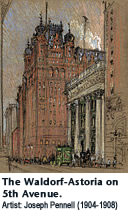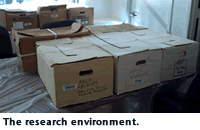The Founding of the Association
by Brenna McLaughlin
Campfire stories surrounding the formation of the Association of American University Presses stretch back to the late 1910s. One such tale, a mildly infamous anecdote, recalls the presses of Harvard and Yale experimenting with jointly hiring a representative to make trade sales calls in New York City. It made sense—neither press at the time had quite enough cross-over titles to support such an expenditure on their own, but they saw that some of their titles should have a larger audience than academics and students. The experiment was not to last: a “Yale man” was hired for the job, and Harvard was naturally suspicious when book orders greatly favored his alma mater.(1)
In 1921, a Mr. Marsh of the University of Chicago Press first proposed, at a meeting with the presses of Columbia, Harvard, Johns Hopkins, Princeton, and Yale, that an association of university presses be formed.(2) The proposal was not then taken up, but university press representatives continued meeting informally during the annual meetings of the National Association of Book Publishers in New York City in order to discuss problems of mutual concern.
The first substantive cooperation among presses, of the type the Association would later support, sprang from these early meetings. On January 18, 1928, representatives of twelve university presses hatched a plan for a joint catalog of titles to be distributed to a shared mailing list. Correspondence between Donald Bean of Chicago and Phelps Soule of the University of Pennsylvania Press sheds light on plans for this meeting, including invitations to a broadening number of university presses—a group that now included Stanford, North Carolina, Duke, Oxford, and others. For the first-time, a day-long agenda was developed, meaning that a space separate from the NABP was needed. Soule and Bean decided to locate a New York City hotel that might offer a reduced rate for a small block of rooms, one of which could serve as a meeting space.

And this is how cooperation among university presses was born: amongst the luxurious surroundings of the original Waldorf-Astoria. When the Hotel Pennsylvania and the Commodore proved too expensive, someone negotiated a rate of $6/single or $9/double at one of the world’s most famous hotels. The organizers were quite pleased—Soule confessed a long-held “ambition to lunch someday at the Waldorf, as it looks very grand from the top of the Fifth Avenue Bus.”(3) In 1929, the hotel site would be demolished for the construction of the Empire State Building, but not before the foundations of AAUP were laid.
So how much did that cost?
The rate the Waldorf-Astoria charged the university presses in 1928 is comparable to a rate of $76/single and $115/double today.
AAUP would be hard-pressed to negotiate such a rate today: the Waldorf=Astoria on Park Avenue advertised 2012 rates between $318 to well over $500 a night for a single room.
The 1928 meeting focused on common problems of advertising and selling, including both more efficient marketing to a core audience of scholars, and affordable ways to sell to a wider trade audience. One idea remains a perennial favorite: Oxford University Press broached their plans for a university press bookstore in Manhattan, and many attending presses agreed to send books on commission to such an outlet. Most of the conversation, though, focused on producing a combined catalog of worthy titles for a pooled mailing list of buyers. Although this joint project would set the stage for continued collaboration, the meeting still ended with emphatic non-formality: “a perfect score of no resolutions and no officers, but…’100% harmony.'”(4)
Thirteen presses participated in this catalog, titled “Shelfward Ho!” (a wit in the group suggested “Thirteen Against Thebes”) and published with an enthusiastic preface by the essayist and novelist Christopher Morley. The immediate results were not entirely positive. Few presses attributed sales to the effort, and the costs had been somewhat higher than expected. The hard calculations presses used to judge the catalog’s value may have surprised Morley, who wrote in the introduction: “Those who manage university presses lead the happiest lives, I imagine, for they are little hampered by mean consideration.”

In the AAUP archives, a handwritten note on the “Shelfward Ho!” file labels it “the ill-fated joint catalog.” However, the pooling of each press’s mailing list of scholarly book-buyers proved prescient and eventually the Educational Directory (originally maintained by the University of Chicago Press) became the foundation of American University Press Services (AUPS) and a core service of AAUP in its first decades.
Despite the disappointing results from the catalog, the informal network of university presses continued to develop joint marketing efforts. In 1931, an advertising scheme called “The Lookout” was launched. A respected book critic, Harry Hansen, was hired to pen a brief bi-weekly column about selected university press titles. Space was purchased in the New York Times, the New York Herald Tribune, and the Saturday Review of Literature to run the column, and reprints of each “issue” were distributed to booksellers around the country. After an initial run, the reprints were agreed to be the most effective element of the scheme. Booksellers wrote requesting additional copies, and distributed them as “book talkers” to their patrons. Still, the expense was considerable and after 13 columns the effort was rolled up.
“Their books push off from the wharf and cry Shelfward Ho!”
—Christopher Morley’s Preface
Annual gatherings continued through the ’30s, with the idea of formalizing an association doggedly advocated by Donald Bean. In 1932, he presented a joking plea to the “producers of highbrow tobacco” proposing various goals that needed to be met, including: to “inform ourselves accurately of the costs of producing [and distributing] our product”; and to “inform [the growers of our raw materials] of the importance of our economic functions and the service which we can render them.” These and other goals, Bean declared, “we cannot accomplish…to the fullest extent by these pleasant yearly ‘smokers,’ or even by increasing the number of these pleasant, social affairs two or four-fold!”(5)
While contemporary ears surely wish that Bean had used another metaphor (perhaps we can recast this as a “Memo to Artisanal Cheese-Producers”?), his humor and tenacity mark the records of these early and un-official endeavors. Bean provided minutes of the annual get-togethers, addressing his fellows occasionally as “erstwhile bootleggers” and signing the memoranda variously “Anonymous Acting Secretary” and “Acting Executive Secretary Pro Tem.” Though cooperation and conversation continued among a growing circle of university presses, now including such publishers as Oklahoma, Minnesota, California, and NYU, the group remained determinedly un-associated.
The happy band faced an unexpected challenge in 1936, when it was announced to the trade that a for-profit company would be formed under the name “United University Presses,” intending to contract with university presses to distribute, sell, and exhibit in a New York showroom those “highbrow tobacco” products. Most of the concerned presses were initially unimpressed with the terms offered and moreso with what seemed to be a pressure tactic of adopting and publicizing such a name without consultation. The firm was eventually convinced (by the stern disapproval of its expected client base) to change its name to University Books Inc. And the realization set in that, though officers and resolutions may be lacking, unity among university presses was not.

On February 8, 1937, a constitution was adopted forming the Association of American University Presses. Twenty-two current members were officially admitted to the Association in its founding year: the University of California Press, the University of Chicago Press, Columbia University Press, Cornell University Press, Duke University Press, Harvard University Press, the University of Illinois Press, Johns Hopkins University Press, Louisiana State University Press, the University of Minnesota Press, the University of New Mexico Press, New York University Press, the University of North Carolina Press, the University of Oklahoma Press, the University of Pennsylvania Press, the University of Pittsburgh Press, Princeton University Press, Rutgers University Press, Stanford University Press, the University of Toronto Press, the University of Washington Press, and Yale University Press. Donald P. Bean, at long last, served as the new association’s elected president from 1938-1939.
Update
In December 2017, the organization changed its name to the Association of University Presses—this was, in fact, the name originally proposed by March in 1921.
Acknowledgements
AAUP records dating from before the Central Office was established are held by the Rare Book & Manuscript Library at Columbia University. I would like to thank archivist Carrie Hintz in particular for her help in accessing the AAUP archives, as well as to the rest of the RBML staff. A finding aid for the collection is available online, for the curious.

Researching the gestation period of AAUP in the clean, contemplative environs of Butler Library’s Rare Book & Manuscript Reading Room was a joy. Future installments of our historical review, however, entail a whole other, much dirtier form of research! Your Central Office staff are currently up to our elbows in boxes of records dating to the ’60s and ’70s that have been kept in off-site storage. The process of bringing these unsorted historical materials under intellectual and physical control is moderately daunting, but Linda McCall and Michael Valcic have been valiant in dealing with the logistics, and Regan Colestock has made great strides in inventorying the boxes.
—August 2012
Notes
1. Donald P. Bean, “A Personal Memoir.” Association of American University Presses Records, Rare Book & Manuscript Library, Columbia University in the City of New York.
2. Donald P. Bean, memorandum to the Administrative Committee of the University of Chicago Press, 22 June 1921. Association of American University Presses Records, Rare Book & Manuscript Library, Columbia University in the City of New York.
3. Phelps Soule to Donald P. Bean, 19 December 1927. Association of American University Presses Records, Rare Book & Manuscript Library, Columbia University in the City of New York
4. Donald P. Bean, memorandum, 1928. Association of American University Presses Records, Rare Book & Manuscript Library, Columbia University in the City of New York
5. Donald P. Bean, “A Memo Recently Addressed to the Producers of Highbrow Tobaccos!”, 1932. Association of American University Presses Records, Rare Book & Manuscript Library, Columbia University in the City of New York.
